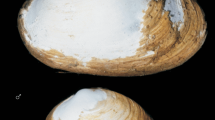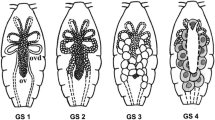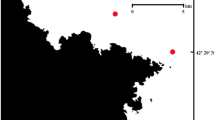Abstract
Sperm are disseminated in vermetid gastropods by spermatophores released freely into the ocean. Spermatophores from 7 species of vermetids, including 3 genera, were obtained from reproductively active males or offshore plankton tows or both. Each vermetid spermatophore consists of a sperm mass containing highly ordered eupyrene and apyrene sperm enveloped concentrically by 3 transparent capsules. Generic and specific differences occur in the size, shape and composition of the sperm mass and capsule. The complexly layered spermatophore is assembled in the male reproductive tract, which includes and elaborate set of pallial reproductive glands for capsule production. Spermatophores are liberated by males into the seawater, and there dispersed by water movements. Some of these drifting spermatophores become entangled in the mucous feeding nets of female vermetids and are then activated by feeding movements. Activation of the complex ejaculatory apparatus appears to result from an interplay of osmotic and mechanical mechanisms. Spermatophores remain viable in the laboratory for 12 to 20 h after release from the male; after 20 h, the sperm mass breaks down and the sperm become immotile. Plankton tows capture some spermatophores with motile sperm and others in which sperm are no longer active. Evolutionary implications of the relationship between production of pelagic spermatophores, sessile mode of life and other aspects of vermetid biology are discussed.
Similar content being viewed by others
Literature Cited
Cazaux, C.: Developpement larvaire de Microspio mecznikowianus. Proc. 4th Eur. mar. Biol. Symp. 4, 247–257 (1971). (Ed. by D. J. Crisp. Cambridge: Cambridge University Press)
Dazo, B. C.: The morphology and natural history of Pleurocera acuta and Goniobasis livescens (Gastropoda: Cerithiacea: Pleuroceridae). Malacologia 3, 1–80 (1965)
Flügel, H.: Ultrastructure of the spermatophores of Siboglinum ekmani Jägersten (Pogonophora). Nature, Lond. 269, 800–801 (1977)
Fretter, V.: The transference of sperm from male to female prosobranch, with reference, also, to the pyramidellids. Proc. Linn. Soc. Lond. 164, 217–224 (1953)
Fretter, V. and A. Graham. British prosobranch molluscs, 755 pp. London: Ray Society 1962
Hadfield, M. G.: The reproductive biology of the California vermetid gastropods Serpulorbis squamigerus (Carpenter, 1857) and Petaloconchus montereyensis Dall, 1919, 174 pp. Ph.D. dissertation, Stanford University 1966
Hadfield M. G.: Nurse eggs and giant sperm in the Vermetidae (Gastropoda). Am. Zool. 9, p.520 (1969)
Hadfield, M. G.: Observations on the anatomy and biology of two California vermetid gastropods. Veliger 12, 301–309 (1970)
Hadfield, M. G., E. A. Kay, M. U. Gillette and M. C. Lloyd: The Vermetidae (Mollusca: Gastropoda) of the Hawaiian Islands. Mar. Biol. 12, 81–98 (1972)
Houbrick, J. R.: Some aspects of the anatomy, reproduction, and early development of Cerithium nodulosum (Bruguiére) (Gastropoda, Prosobranchia). Pacif. Sci. 25, 560–565 (1971)
Houbrick, J. R.: Studies on the reproductive biology of the genus Cerithium (Gastropoda: Prosobranchia) in the western Atlantic. Bull. mar. Sci. 23, 875–904 (1973)
Hyman, L. H.: The invertebrates. Vol. VI. Mollusca I, 792 pp. New York: McGraw-Hill Book Co. 1967
Morton, J. E.: The evolution of vermetid gastropods. Pacif. Sci. 9, 3–15 (1955)
Morton, J. E.: Form and function in the evolution of the Vermetidae. Bull. Br. Mus. nat. Hist. (Zool.) 11, 585–630 (1965)
Rice, S. A.: Spermatophores and sperm transfer in spionid polychaetes. Trans. Am. microsc. Soc. 97, 160–170 (1978)
Scheuwimmer, A.: Sperm transfer in the sessile gastropod Serpuloribis (Prosobranchia: Vermetidae). Mar. Ecol. Prog. Ser. 1, 65–70 (1979)
Webber, H. H.: Gastropoda: Prosobranchia. In: Reproduction of marine invertebrates. Vol. IV. Molluscs: gastropods and cephalopods, pp 1–97. Ed. by. A. C. Giese and J. S. Pearse. New York: Academic Press 1977
Woodard, T. M.: Anatomy of the reproductive system of Goniobasis laqueata (Say). J. Tenn. Acad. Sci. 9, 243–259 (1934)
Woodard, T. M.: The function of the apyrene spermatozoa of Goniobasis laqueata (Say). I. The behavior of the apyrene and eupyrene spermatozoa under natural and artificial conditions. J. exp. Zool. 85, 103–125 (1940)
Yonge, C. M.: Notes on the feeding and digestion in Pterocera and Vermetus, with a discussion on the occurrence of the crystalline style in the Gastropoda. Scient. Rep. Gt Barrier Reef Exped. 1(10), 259–281 (1932)
Yonge, C. M. and T. E. Thompson: Living marine molluscs, 288 pp. Glasgow: William Collins Sons & Co., Ltd. 1976
Zimmer, R. L.: The morphology and function of accessory reproductive glands in the lophophores of Phoronis vancouverensis and Phoronopsis harmeri. J. Morph. 121, 159–178 (1967)
Author information
Authors and Affiliations
Additional information
Communicated by N. D. Holland, La Jolla
Rights and permissions
About this article
Cite this article
Hadfield, M.G., Hopper, C.N. Ecological and evolutionary significance of pelagic spermatophores of vermetid gastropods. Mar. Biol. 57, 315–325 (1980). https://doi.org/10.1007/BF00387574
Accepted:
Issue Date:
DOI: https://doi.org/10.1007/BF00387574




